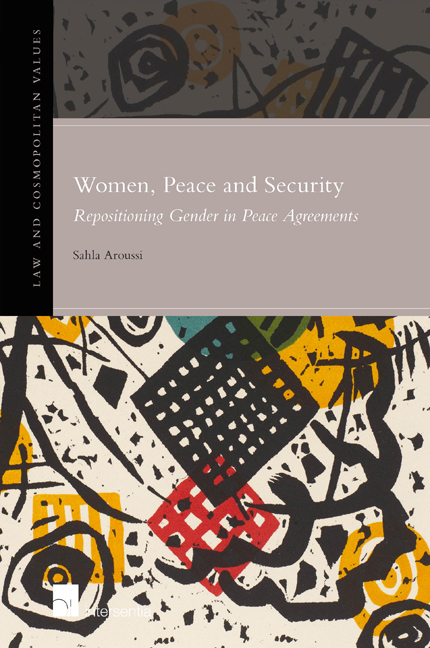Book contents
- Frontmatter
- Acknowledgements
- Contents
- List of Abbreviations
- List of Tables and Figures
- Introduction
- Chapter 1 The United Nations Resolutions on Women, Peace and Security
- Chapter 2 The Gender of Peace Agreements
- Chapter 3 Overview of Gender Provisions in Peace Agreements
- Chapter 4 Women's Political Participation in Peace Agreements
- Chapter 5 Gender-Based Violence
- Chapter 6 Perspectives from the Field
- Conclusion
- References
- Law and Cosmopolitan Values
- Instructions to authors
- Frontmatter
- Acknowledgements
- Contents
- List of Abbreviations
- List of Tables and Figures
- Introduction
- Chapter 1 The United Nations Resolutions on Women, Peace and Security
- Chapter 2 The Gender of Peace Agreements
- Chapter 3 Overview of Gender Provisions in Peace Agreements
- Chapter 4 Women's Political Participation in Peace Agreements
- Chapter 5 Gender-Based Violence
- Chapter 6 Perspectives from the Field
- Conclusion
- References
- Law and Cosmopolitan Values
- Instructions to authors
Summary
The passing of Security Council resolution 1325 on women, peace and security in October 2000 marked the beginning of a global agenda on women in conflicts, peacemaking, peacekeeping and post-conflict reconstruction. Reviewing the implementation of the UN agenda is critically important since such work feeds into policy areas and contributes to the adoption and continuous improvement of gender-sensitive strategies at the national and international levels. This is particularly so with the impending Fifth World Women Conference, almost 20 years after the Beijing Platform for Action. To date, very little research has been done on the implementation of the UN resolutions on women, peace and security in peace treaties. Hence, this book is timely, offering a valuable contribution not only to the literature on the UN resolutions on women, peace and security, but also to the literature on peace agreements, peace mediation, and transitional justice, and to practitioners working in this field. The study has adopted an interdisciplinary approach bringing together various bodies of literature and raising key theoretical and practical questions that tend to be overlooked by scholars working within the strict boundaries of the distinct disciplines. The book has introduced a new dataset that provides important comprehensive evidence on the extent to which the UN resolutions on women, peace and security have had an impact on peace agreements. Through the reflections of elite peacemakers, the book provides insights into the practice of peacemaking and the challenges of implementing WPS resolutions on the ground. The voices of the practitioners have, moreover, added exceptional depth and breadth to the theoretical discussions in this volume. Having established, on one hand, the great potential of the UN Security Council resolutions and, on the other, their limited implementation on the ground, the findings of this study have important policy implications. Governments, international organisations and non-governmental organisations must now refocus their efforts on bridging the gap between the theory and practice of gender sensitive peacemaking. In particular, further consideration must be given to peace mediation processes to ensure that mediators are willing and able to place gender issues on their list of priorities for agendas in peace negotiations. Mainstreaming gender issues in peace agreements is only the beginning of a long struggle to achieve gender equality in post-conflict societies but it is a struggle that women must win to increase the likelihood of an inclusive and fair post-conflict transition.
- Type
- Chapter
- Information
- Women, Peace, and SecurityRepositioning gender in peace agreements, pp. 293 - 306Publisher: IntersentiaPrint publication year: 2015

